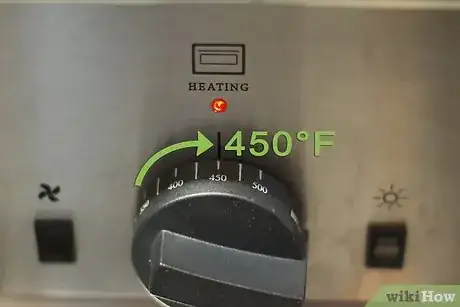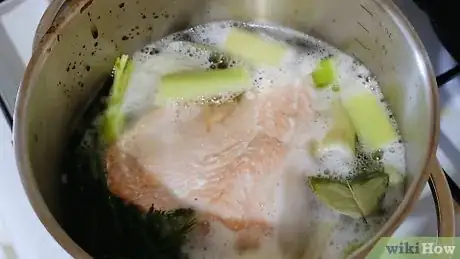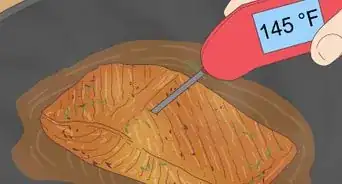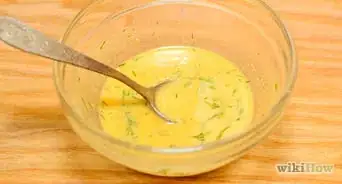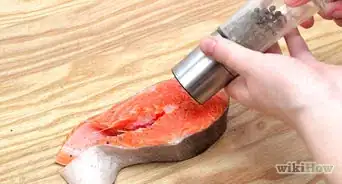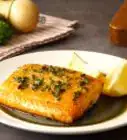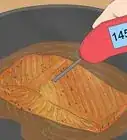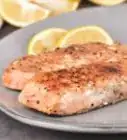This article was co-authored by Ollie George Cigliano. Ollie George Cigliano is a Private Chef, Food Educator, and Owner of Ollie George Cooks, based in Long Beach, California. With over 20 years of experience, she specializes in utilizing fresh, fun ingredients and mixing traditional and innovative cooking techniques. Ollie George holds a BA in Comparative Literature from The University of California, Berkeley, and a Nutrition and Healthy Living Certificate from eCornell University.
There are 9 references cited in this article, which can be found at the bottom of the page.
wikiHow marks an article as reader-approved once it receives enough positive feedback. In this case, several readers have written to tell us that this article was helpful to them, earning it our reader-approved status.
This article has been viewed 109,007 times.
The trick to making well-cooked fish is often deceptively simple, and salmon is no exception. With just a little seasoning and some proper cooking techniques, a salmon filet can provide some of the best flavors around, even without the skin. Whether baked, grilled, or poached, salmon can be a wonderful treat that will make any dinner shine.
Ingredients
- 4-6 oz (112-170 grams) salmon filet
- Olive oil
- Salt and pepper to taste
- 1 lemon or lime (optional)
- Dill, garlic, parsley, and tarragon to taste (optional)
- 4-6 oz (112-170 grams) salmon filet
- Olive oil
- Salt and pepper to taste
- 1 lemon or lime (optional)
- Dill, garlic, parsley, and tarragon to taste (optional)
- 4-6 oz (112-170 grams) salmon filet
- 1 quart (1 L) water
- 1 lemon
- 1 medium onion, halved
- 1 stalk celery, chopped into chunks
- 1 bay leaf
- Fresh thyme, to taste
- Fresh dill, to taste
- Salt, to taste
- Pepper, to taste
Steps
Making Baked Skinless Salmon
-
1Preheat your oven to 450° F (232° C). To help your salmon bake evenly, arrange your racks so you can place a baking dish in the very center, equally distant from the top and bottom.[3]
-
Video Player is loading.
This is a modal window.
The media could not be loaded, either because the server or network failed or because the format is not supported.2Brush your salmon with olive oil. Use a brush to spread a light amount of olive oil over your filet. This will help your salmon retain moisture while stuck in the oven. If your salmon is large, cut it into smaller filets before spreading any oil.Advertisement -
Video Player is loading.
This is a modal window.
The media could not be loaded, either because the server or network failed or because the format is not supported.3Season your salmon with herbs, spices, and citrus. To season your salmon thoroughly, sprinkle pinches of salt, pepper, dill, garlic, parsley, and tarragon over the filet. After, squeeze half of your citrus fruit over the salmon for extra flavor and juiciness. Make sure to season both sides before baking. -
Video Player is loading.
This is a modal window.
The media could not be loaded, either because the server or network failed or because the format is not supported.4Place your salmon in a baking dish coated with nonstick cooking spray. You can also use aluminum foil or non-stick baking sheets as an alternative to cooking spray. -
Video Player is loading.
This is a modal window.
The media could not be loaded, either because the server or network failed or because the format is not supported.5Bake your salmon for about 5 minutes per every 1⁄2 inch (1.3 cm) of thickness. For most salmon, this leads to baking times of around 15 minutes. Salmon can dry out quickly, so make sure you keep an eye on it while cooking.[4] -
Video Player is loading.
This is a modal window.
The media could not be loaded, either because the server or network failed or because the format is not supported.6Serve your salmon when it flakes easily. To check if your salmon is ready, scrape the center of the fish with a fork to see if it's done. If it doesn't slake, leave it in for a few more minutes.
Making Grilled Skinless Salmon
-
Video Player is loading.
This is a modal window.
The media could not be loaded, either because the server or network failed or because the format is not supported.1Preheat your grill to a medium high setting. This will cook your salmon thoroughly and evenly. If you’re using a charcoal grill, spread the coals out, light the fire, and wait about 5 minutes before you start cooking.[5] -
Video Player is loading.
This is a modal window.
The media could not be loaded, either because the server or network failed or because the format is not supported.2Oil your grill to prevent sticking. While your grill is heating up, run a cloth dipped in olive oil over your grates. This will help prevent your salmon from sticking to the surface. Keep the cloth between your hand and the grates to avoid burning yourself.[6] -
Video Player is loading.
This is a modal window.
The media could not be loaded, either because the server or network failed or because the format is not supported.3Spread a light amount of olive oil over your filet. Use a brush to coat your fish with a thin layer of olive oil. This will pack in moisture while your salmon is grilling. If your filet is large, cut it into smaller pieces before using any olive oil. -
Video Player is loading.
This is a modal window.
The media could not be loaded, either because the server or network failed or because the format is not supported.4Sprinkle herbs, spices, and citrus over your salmon. To add additional flavor, sprinkle your fish with a small amount of salt, pepper, dill, garlic, parsley, and tarragon. For additional zest, squeeze half of your lemon or lime over the filet. Before grilling, make sure you cover both sides.- To give your salmon more flavor, place it in a wet marinade an hour before cooking. Popular ingredients include lemon juice, sesame oil, honey, and hot sauce.[7]
-
Video Player is loading.
This is a modal window.
The media could not be loaded, either because the server or network failed or because the format is not supported.5Grill your salmon until one side is golden brown. Place the filet on a part of the grill where heat is evenly distributed, avoiding spots directly above large flames or burners. Depending on the size of your filet and the heat of the grill, each side could take between 4 and 8 minutes to cook.- To give your salmon grill-marks, place it at a 45° angle to the grate.
-
Video Player is loading.
This is a modal window.
The media could not be loaded, either because the server or network failed or because the format is not supported.6Use a wide spatula to flip the salmon over and cook the other side. Avoid tongs, which can force moisture out of the fish, and skewers, which can cause the fish to break apart. -
Video Player is loading.
This is a modal window.
The media could not be loaded, either because the server or network failed or because the format is not supported.7Move your salmon off the heat to finish cooking. To see if your salmon is close to done, press your spatula into the center of the fish. If it flakes and causes clear juice to run out, it is ready to be moved. Fish can dry out quickly, so taking your salmon off the grill will ensure that residual heat does not overcook or burn it.
Making Poached Skinless Salmon
-
Video Player is loading.
This is a modal window.
The media could not be loaded, either because the server or network failed or because the format is not supported.1Fill a pot with cold water, lemon, onion, celery, salt, and herbs. Fill a pot with 1 US-quart (950 ml) (1 L) of cold water. Either squeeze your lemon into the water or cut it into thin slices to insert. Place your onions, celery, and bay leaf into the pot. Sprinkle thyme, dill, and salt on top to taste.- For more flavor, try adding peppercorns, other vegetables like carrots, or cooking liquids like chicken stock and white wine.[8]
-
Video Player is loading.
This is a modal window.
The media could not be loaded, either because the server or network failed or because the format is not supported.2Add your salmon filet and heat to a medium temperature. To avoid overcooking your fish, keep your pot well below boiling, aiming for a temperature around 170° F (76° C). If your water does not fully cover the salmon, add just enough to do so.- Do not preheat your pot. Starting cold will help your salmon retain moisture and avoid overheating.[9]
-
3Cook your salmon until it is opaque and flakes easily. Let your salmon simmer until it can be easily pulled apart by a fork and is no longer transparent on the inside. Depending on the exact heat, this could take between 20 and 30 minutes. Poached salmon will not change colors as drastically as grilled or baked salmon, so pay extra attention to the opacity and toughness.
-
Video Player is loading.
This is a modal window.
The media could not be loaded, either because the server or network failed or because the format is not supported.4Season with salt, pepper, and herbs. Sprinkle your salmon with a small amount of salt, pepper, thyme, and dill. Poached salmon has a naturally clean, light flavor, so avoid excessive seasoning. Squeeze lemon over the top to add a zesty kick.
References
- ↑ https://www.livestrong.com/article/542579-how-to-cook-skinless-salmon/
- ↑ http://www.seriouseats.com/recipes/2016/05/poached-salmon-dill-yogurt-sauce-recipe.html
- ↑ https://www.reluctantgourmet.com/oven-rack-position/
- ↑ https://www.thekitchn.com/how-to-cook-salmon-in-the-oven-cooking-lessons-from-the-kitchn-204559
- ↑ http://www.seriouseats.com/2010/04/grilling-how-hot-heat-fire-temperature-for-food-meat-burgers-chicken-veggies-fish.html
- ↑ http://www.seriouseats.com/2012/07/how-to-grill-fish.html
- ↑ https://www.bonappetit.com/test-kitchen/cooking-tips/article/grilled-salmon-marinades-recipes
- ↑ http://www.washingtonpost.com/wp-dyn/articles/A5981-2004Jun1.html
- ↑ http://www.seriouseats.com/2016/05/how-to-poach-salmon.html
About This Article
To bake your skinless salmon, start by lightly brushing it with olive oil, seasoning it, and squeezing a little lemon juice on top. Then, place it on a baking dish coated with nonstick cooking spray. Bake it at 450 degrees Fahrenheit for about 15 minutes or until it flakes easily when you scrape it with a fork. You can also grill your skinless salmon. Like baking your salmon, brush it with olive oil and flavor it to your taste. Grill it for 4 to 8 minutes or until one side is golden brown, then flip it and cook the other side for a few more minutes. For more tips, including how to poach your skinless salmon, read on!
